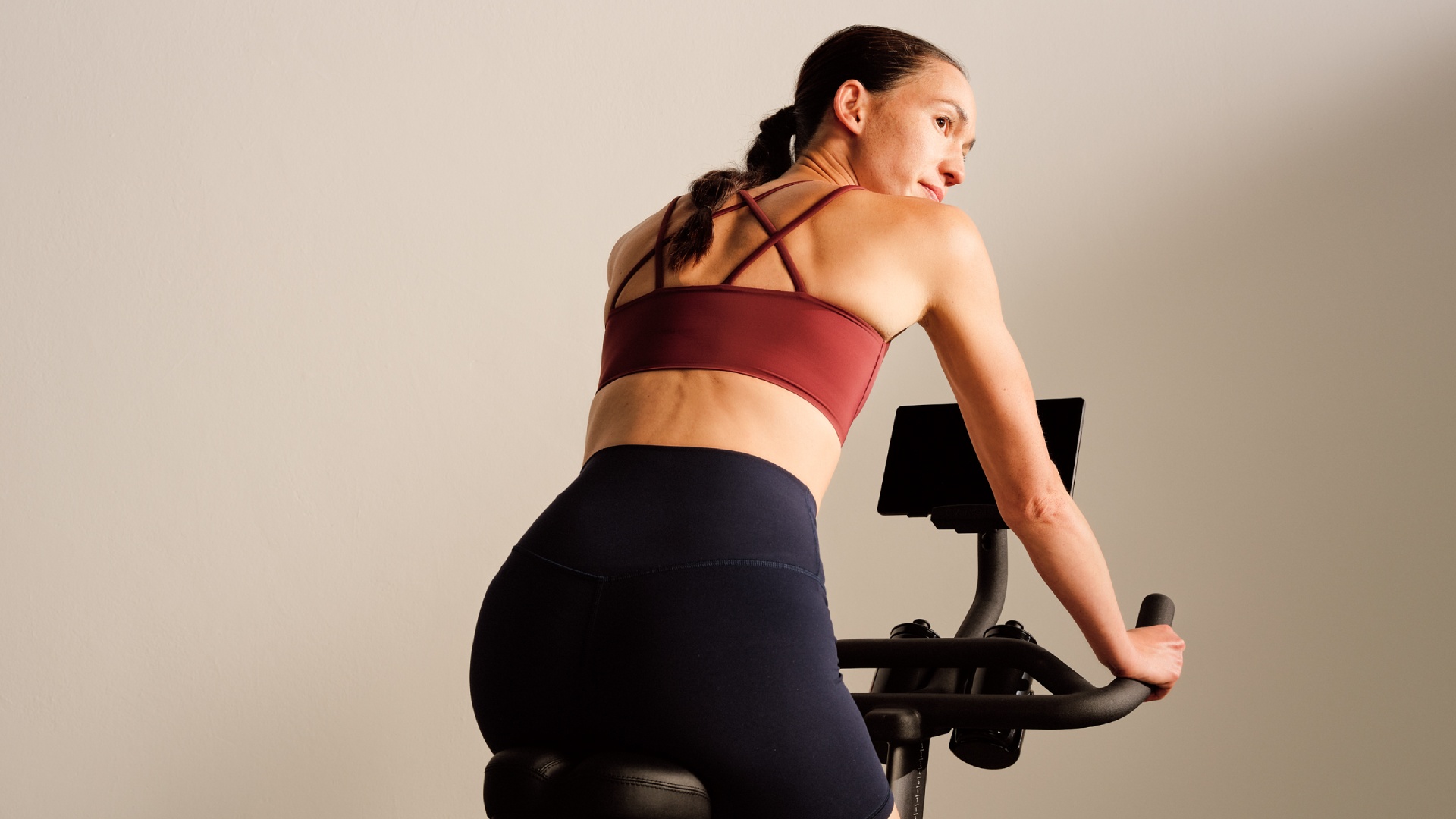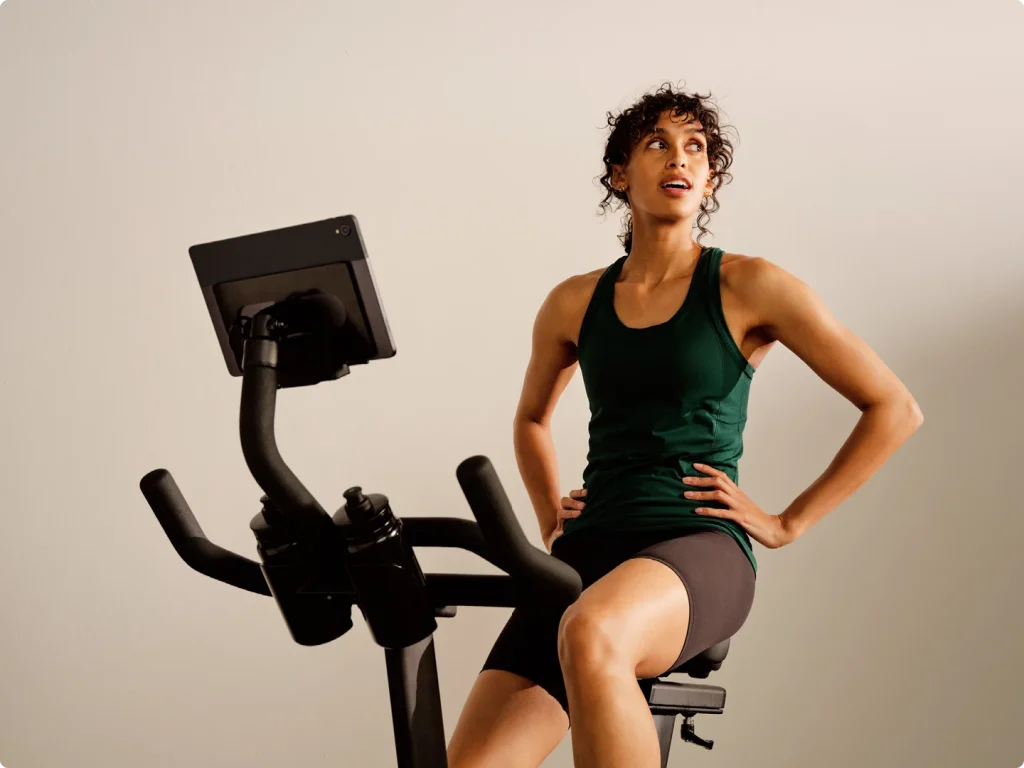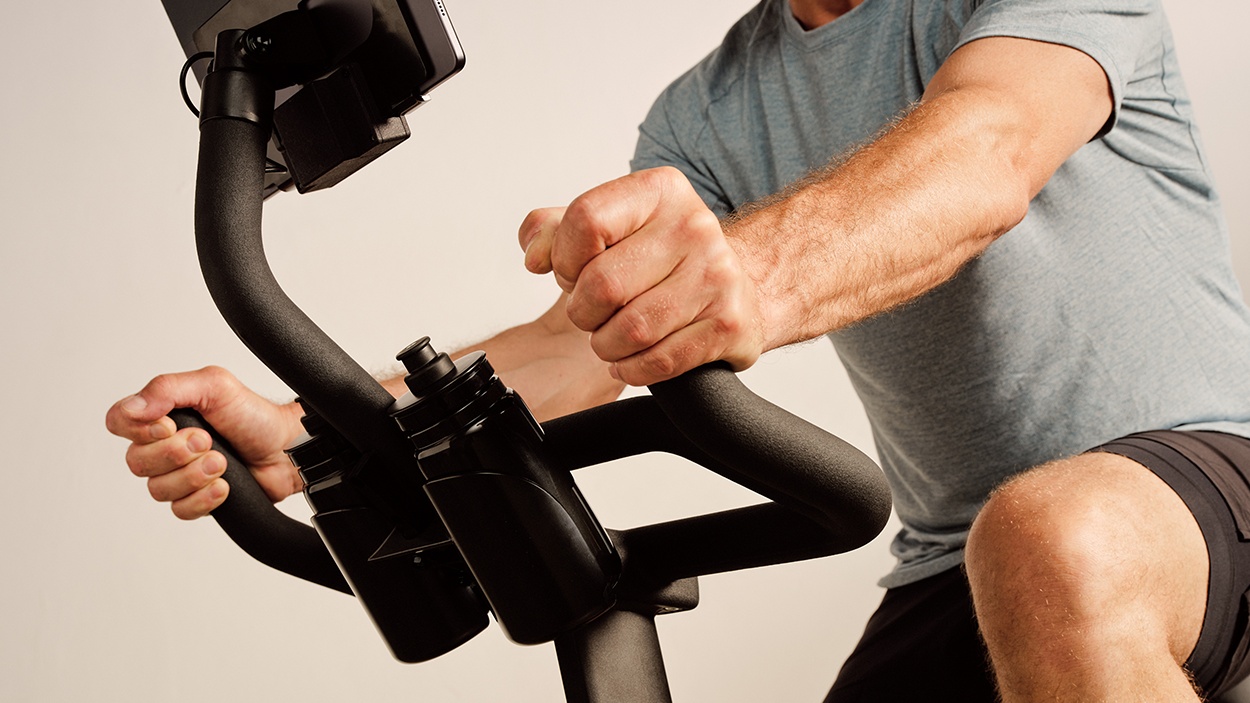High-Intensity Interval Training (HIIT) delivers an array of health benefits in a time-efficient manner. These workouts stimulate metabolic changes conducive to weight loss, increased muscle mass, sustained excess post-exercise oxygen consumption (EPOC), and heightened cardiorespiratory fitness. For many individuals, HIIT workouts offer a time-efficient and refreshing alternative to a 45-minute steady-state cardio session. In this guide, we present 8 carefully curated HIIT cycling workouts tailored to various fitness levels for easy integration into your existing regimen.
The benefits of HIIT workouts
HIIT consists of short bursts of strenuous exercise alternated with recovery periods. During the exercise intervals, the heart performs at 80-95% of its maximum rate. You need to target heart zones 4 and 5 for the effort and zone 1 for the recovery. HIIT workout usually lasts between 10 and 30 minutes but advanced athletes can do it up to 1 hour.
HIIT is one of the most time-efficient ways to burn calories. According to this study, HIIT burns 25–30% more calories than resistance and moderate-pace aerobic training of the same length. A large part of calorie burn happens during the excess post-exercise oxygen consumption (EPOC)—the next few hours after the training when your body actively consumes oxygen in order to restore itself to its resting metabolic level. By repeating several bouts of intense exercise, you are stacking your oxygen debt across every round to create a cumulative effect. That’s why HIIT is known to produce the greatest and longest EPOC effect than any other type of exercise.
Notably, HIIT accelerates fat oxidation and specifically targets fat tissue preserving your muscles. Further research showed that a 15-week HIIT program led to a 9-times bigger decrease in subcutaneous fat mass than a 20-week steady-pace endurance training program, despite having a twice smaller energy cost. A 2019 study demonstrated that participants involved in the HIIT sessions lost 28.5% more fat mass than those who did moderate-intensity continuous training.
HIIT pushes the limit of the cardiorespiratory system training your heart and lungs to perform at their maximum capacity. This is particularly true for aerobic high-intensity intervals.
After comparing 4 groups of people that performed endurance training and 3 types of HIIT for 8 weeks, researchers found a significant increase in VO2 max (the main indicator of aerobic fitness) and stroke volume of heart in all 3 HIIT groups. The increase varied from 5.5% to 7.2%.
HIIT also appears to be effective at preventing and controlling hypertension and improving glucose levels, as well as being beneficial for heart health.
HIIT and cycling
HIIT emerged in the early 20th century as a pioneering training methodology for Olympic cycling and running. Fast forward to today, and HIIT cycling routines are highly adaptable, especially with the use of a stationary exercise bike that allows for precision control over intervals and resistance settings.
Before you start your HIIT cycling workout, make sure that you follow these guidelines:
- Always start with a proper 5-10-minute warm-up. Not only will this protect your muscles from potential injury, but it will also improve your performance during the first rounds of HIIT training. Otherwise, you may lose 25-30% of a short training on the buildup.
- Make sure that your intervals are intense enough. You should be performing at 80%-95% of your maximum heart rate, otherwise, your body won’t do this metabolic switch. If you do sprint intervals, your target heart should be at 100% or even higher. As your heart strengthens, you will need to increase exercise intensity to stay in the right zone.
- There are different ways of measuring the intensity of your exercise. Cycling power (FTP) is considered to be the most accurate metric. You can run FTP tests on CAROL Bike periodically to stay on top of your progress. Other metrics you can track are heart rate, cadence (revolutions per minute), resistance levels, and rate of perceived exertion (RPE).
- Increasing the training time doesn’t necessarily increase its effectiveness. It’s better to do shorter all-out training than to perform intervals half-heartedly. In the beginning, you can aim for a 20-30-minute effective workout.
- HIIT cycling workouts put you at risk of overtraining. For new cyclists, it is recommended to schedule 2-3 sessions per week. You can do steady-state cycling sessions in between.

HIIT is one of the most time-efficient ways to burn calories. According to a study, HIIT burns 25–30% more calories than resistance and moderate-pace aerobic training of the same length.
1. Classic 30/30 HIIT cycling workout for beginners
A beginner-friendly routine featuring the “golden standard” 30-second intervals. This workout has a simple and straightforward structure with short intervals.
- 5 mins – Warm-up (pedal easy in zone 1)
- 30 seconds – Intense cycling (zone 5)
- 30 seconds – Rest (zone 1)
- Repeat 10 times
- 5 mins – Cooldown (pedal easy in zone 1)
2. REHIT—the next-generation HIIT
Reduced Exertion HIIT (REHIT) is the next-generation HIIT that delivers the fitness benefits of a 20-minute interval session in just 5 minutes. This training protocol was developed by scientists looking for the shortest, most efficient way to exercise.
REHIT is based on research that has shown that 2×20-second all-out sprints are enough to deplete up to 30% of the body’s glycogen stores and trigger metabolic changes that increase calorie afterburn and significantly improve aerobic fitness.
According to research, in just 8 weeks you can achieve a 12% increase in cardiorespiratory fitness and reduce your risk of type 2 diabetes by 62%. You will also burn more calories on a 15-minute CAROL ride compared to a 30-minute run.
CAROL Bike is the only stationary bike that accurately re-creates REHIT outside of the lab. Its AI automatically tailors the resistance levels to maintain supra-maximal intensity every training session.
- 20 seconds – 2 mins – Warm-up
- 20 seconds – Sprint 1 (supra-maximal intensity)
- 1-3 mins – Recovery
- 20 seconds – Sprint 2
- 3 mins – Recovery

Developed in collaboration with leading exercise researchers, CAROL Bike offers the most effective, time-efficient workout.
3. Pyramid workout
During Pyramid HIIT workouts, you gradually increase and decrease the intensity or length of your intervals. This Pyramid workout focuses on increasing exercise time. You can do a similar workout increasing and decreasing the cadence.
- 5-mins – Warm-up
- 20 seconds – Intense cycling (zone 5)
20 seconds – Rest - 30 seconds – Intense cycling (zone 5)
30 seconds – Rest - 40 seconds – Intense cycling (zone 5)
40 seconds – Rest - 50 seconds – Intense cycling (zone 5)
50 seconds – Rest - 60 seconds – Intense cycling (zone 5)
60 seconds – Rest - 50 seconds – Intense cycling (zone 5)
50 seconds – Rest - 40 seconds – Intense cycling (zone 5)
40 seconds – Rest - 30 seconds – Intense cycling (zone 5)
30 seconds – Rest - 20 seconds – Intense cycling (zone 5)
20 seconds – Rest - 5-minute cool down
4. Tabata-style intervals
A high-intensity, 4-minute Tabata cycle consisting of x8 20-second rounds with 10-second rest periods. Cyclists usually aim for 170% FTP when performing a Tabata workout. This is a high effort level so you may end up feeling exhausted even after 1 cycle. If you are fit enough, you can perform several Tabata cycles increasing your training time by up to 20 minutes.
- 5 mins – Warm-up
- 20 seconds – Intense cycling (170% FTP)
10 seconds – Rest - Repeat 8 times
- 5 mins – Rest between the cycles
- Repeat the cycle up to 4 times
- 5 mins – Cooldown
5. Hill intervals
A steep hill workout is a great way to increase muscular strength, train your body to go beyond your threshold, and better manage lactic acid buildup in muscles during anaerobic exercise.
- 5 mins – Warm-up
- 30 seconds – Hill climbing (RPE – 8-9/10)
- 30 seconds – Rest
- Repeat 10 times
- 5 mins – Recovery
- 3 mins – Hill climbing (RPE – 6-7/10)
- 2 mins – Rest
- Repeat 3 times
- 5 mins – Cooldown
6. Cardio conditioning
In this workout, you train your aerobic capacity by gradually increasing your target heart rate (HR) with each interval.
- 5mins – Warm-up
- 20 seconds – Intense cycling (80% max HR)
- 40 seconds – Rest (easy pedaling at 30% max HR)
- 20 seconds – Intense cycling (85% max HR)
- 40 seconds – Rest
- 20 seconds – Intense cycling (90% max HR)
- 40 seconds – Rest
- 20 seconds – Intense cycling (95% max HR)
- 40 seconds – Rest
- 5 mins – Cooldown
7. 5x5 intervals
This is one of the classic HIIT bike workouts used by elite cyclists to prepare for races. It requires an all-out effort so it is recommended for advanced levels only.
This workout is great for raising your threshold power and improving VO2max. You will see the results after 8 weeks of consistent training.
- 5 mins – Warm-up
- 5 mins – Cycling at maximum intensity (110%-120% FTP)
- 5 mins – Rest
- Repeat 5 times
- 5 mins – Cooldown
8. Cadence & Resistance HIIT workout
This workout targets both your aerobic capacity and muscular strength. In the first part, you make your heart race by cycling at a high speed, and in the second part, you increase resistance to engage your muscles. You will need to focus on different cycling metrics: cadence and resistance.
- 5 mins – Warmup
- 30 seconds – Intense cycling (High cadence/low resistance)
- 30 seconds – Rest
- Repeat 10 times
- 5 mins – Rest
- 30 seconds – Intense cycling (High resistance/low cadence)
- 30 seconds – Rest
- Repeat 10 times
- 5 mins – Cooldown
Incorporating these 8 HIIT cycling workouts can markedly elevate your indoor cycling experience. These sessions offer a holistic approach to fitness, targeting fat loss and cardiorespiratory improvement. As you integrate these workouts, be mindful of the mental and physical demands, and calibrate the intensity to mitigate the risk of overtraining.

Got a question? Let's book a call.
All our experts have MSCs in Exercise Science, and they’re here to answer your questions. Whether it’s about the science behind CAROL Bike, or general fitness advice, whatever’s on your mind—we’re here for you.
What is an elliptical machine?
An elliptical machine (also known as a cross-trainer) can be used for walking, stair-climbing or running without putting too much pressure on your joints. This is because an elliptical trainer is a low-impact, weight-bearing cardio machine. It even features handlebars to help those with upper body issues maintain their balance.
An elliptical workout not only helps you to burn calories and lose weight, but it is also great for strengthening muscles and improving cardiovascular health. It engages both the lower and upper body muscles, providing a whole body workout.


